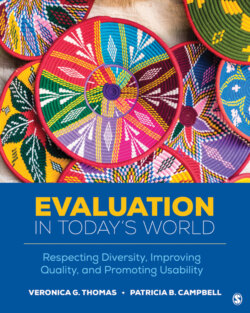Читать книгу Evaluation in Today’s World - Veronica G. Thomas - Страница 159
На сайте Литреса книга снята с продажи.
Floraline I. Stevens
ОглавлениеFloraline I. Stevens served as the director of the Research and Evaluation branch of the Los Angeles Unified School District (LAUSD) from 1979 to 1994. She was also a senior research fellow for the National Center for Education Statistics (NCES) in Washington, DC (1991–1992), and a program director for the National Science Foundation (NSF) in the Education and Human Resources Directorate (1992–1994). While at NSF on an interagency personnel assignment from the LAUSD, Stevens conceived the idea for the NSF’s seminal publication, User-Friendly Handbook for Project Evaluation: Science, Mathematics, Engineering, and Technology Education. This handbook was developed to provide principal investigators and project evaluators with a basic understanding of selected approaches to evaluation. Further, the handbook builds on firmly established principles, blending technical knowledge and common sense to meet the special needs of NSF programs and projects. This handbook has been updated several times and is still currently in use.
Stevens (2000) indicated that she became an evaluator in 1965 when the Elementary and Secondary Education Act (ESEA, now referred to as the Every Student Succeeds Act, or ESSA) Title I legislation was enacted and federally funded education programs were being implemented in the LAUSD:
[T]here were no evaluation types in the school district. However, in response to the federal guidelines, the school district recruited a cadre of persons who had training in counseling because of their coursework in test and measurement, statistics, and research design…. We knew nothing about evaluation theories and evaluation procedures. (p. 42).
Stevens described how she and her colleagues overcame difficulties attendant to being responsive to culture during an evaluation project in this large, diverse metropolitan school district, noting that their extensive knowledge of the culture in the classroom and cultural background of the students helped them overcome difficulties in collecting accurate data in the schools where the ESEA Title I programs were operating. She said she (and her colleagues of color) knew how to gain access to people and information in schools, a critical element in evaluation. But equally important, Stevens indicated that she knew when the information provided did not make sense.
It was from those early experiences that Stevens later became an evaluator of her first science education project, an ESEA Title III, K–12 ecology- and biology-focused project. Subsequently, she evaluated many K–12 science education and science-focused programs. As the director of the Research and Evaluation branch of the LAUSD, Stevens developed ongoing programs of professional development to assist the evaluation staff to become better qualified. She played a significant role in focusing attention to issues of race, culture, and context in program evaluation. In situations where programs involved ethnically diverse participants and stakeholders, Stevens (2000) called for the creation of multiethnic evaluation teams to increase the chances of really hearing the voices of underrepresented students. Stevens was also a major champion of evaluation capacity building, especially in relation to increasing the number of minorities in the evaluation field. In the 1990s, she argued that the NSF should step forward to train minority evaluators of science and technology projects.
When Stevens retired from the LAUSD in 1994, she formed Stevens and Associates, an independent evaluation and research consulting firm. Her early work and involvement with various NSF minority capacity-building efforts had a visible impact on the developing scholarship related to culturally responsive evaluation.
